what organ system does the hypodermis belong to?
The human body has different organs located in various parts of the trunk. These organs work together to course xi organ systems that play a vital role in torso physiology.
The organ systems include
- Skeletal system
- Muscular organisation
- Respiratory system
- Cardiovascular system (Circulatory system)
- Digestive system
- Nervous system
- Endocrine organisation
- Reproductive system
- Urinary system
- The lymphatic organisation (Humeral arrangement)
- Integumentary organization
- An organ is formed by a group of tissues. These tissues are, in turn, formed from a group of cells.
- A ready of organs working together towards a mutual goal is classified as an organ organisation.
- For example, the digestive system is an organ system comprising organs like the stomach, esophagus, buccal-cavity, intestine, rectum, pancreas, liver, etc.
- These all organs are concerned with one important physiological role, namely digestion.
- If one of these organs is disturbed, then the whole digestive office is disturbed.
- So these organs are perfectly interlinked and connected to bear out 1 specific physiological part effectively.
- In most cases, every organ in the organ system has simply one specific physiologic function.
- But some organs may be a part of one or more organ systems.
- For example, the pancreas is a part of the digestive system but also plays a prominent office in the endocrine system.
- This is considering it secretes digestive enzymes through its exocrine glands and insulin-like hormones through its endocrine portion.
- The organ systems are similar in terms of function and anatomy, starting from amphibians to higher animals. The unlike organ systems in the human being body include.
Details on Organ Systems with Functions
1. Skeletal system
- This organisation consists of the bones of the trunk.
- These basic are made of bone cells and cartilage cells, which are hardened.

- They provide the body a proper shape, frame, and support to the organs.
- In some places, they form bony compartments.
- These compartments include the skull and thorax, center sockets, etc., which protect the essential organs similar the encephalon, middle, lungs, eyes.
- The skeletal system is as well flexible and movable at places called joints.
- These joints assistance in the trunk'southward movements in coordination with skeletal muscles.
2. Muscular system
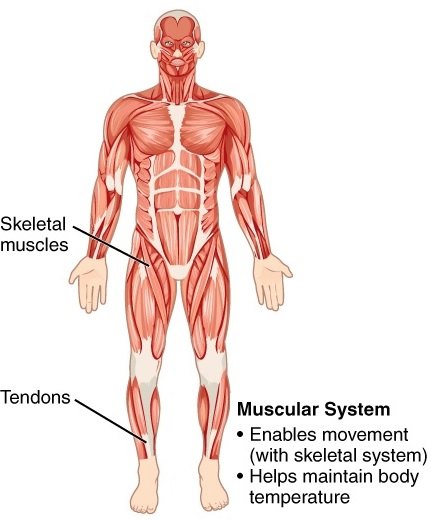
- This arrangement comprises muscles that are responsible for the movements of the body.
- They are of three types as skeletal, cardiac, and smooth muscles.
- Skeletal muscles help in moving the body from 1 place to another. Functions similar walking, running, moving, lifting, bending are possible due to skeletal muscles.
- On the other hand, the cardiac muscles form the heart and assistance in the pumping of the blood. It forces the blood to flow through the arteries such that it reaches the deep and remote areas of the body.
- While the smooth muscles form the organs like the stomach, intestine, uterus, urinary bladder, etc.
- These polish muscles bring well-nigh movement within the body to aid physiology.
3. Respiratory system
- The respiratory system helps to absorb the atmospheric oxygen from the air and supply it to the trunk.

- The respiratory system comprises the organs like the nose, larynx, bronchi, and lungs.
- The path is called equally respiratory tract and a diaphragm made of skeletal muscle separates it from the abdomen.
- The oxygen is absorbed into the blood from the lung alveoli and carried to tissues. In the tissues and cells, it helps to generate energy through the oxidation of glucose in the mitochondria.
- Besides, the respiratory system also helps in speech (making sounds), excretion by exhalation (alcohol), and also metabolism.
iv. Cardiovascular system
- The cardiovascular organization circulates the blood in the body.
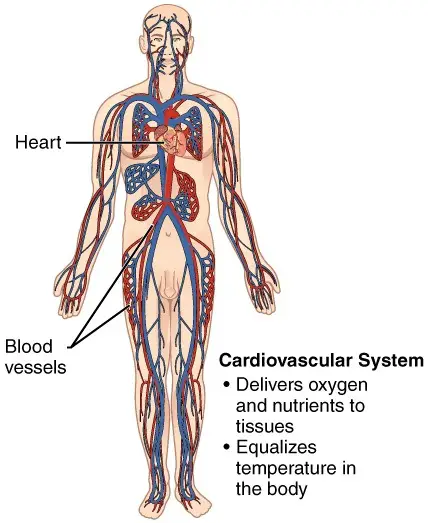
- It comprises blood, blood vessels like the arteries, veins, capillaries, and center.
- The main functions of this system are
- Maintenance of uniform temperature,
- Supply of oxygen and diet to all the cells and tissues
- Collection waste thing and send it urinary system.
- To comport hormones to the target organs.
5. Digestive system

- This system is meant to break down the food and absorb nutrients into the blood apportionment.
- It consists of the oral fissure, teeth, esophagus, stomach, liver, pancreas, intestine, rectum, and anus.
- It is the just route through which the nutrient can enter into the body.
- The nutrient is breakdown into smaller forms similar carbohydrates (disaccharides), amino acids, and fatty acids for easy absorption into the body.
six. Nervous organisation

- This is chosen the principal body organization as it controls all the other organ systems of the body.
- The nervous organization regulates the whole-body physiology, functions and movements.
- It has a encephalon, spinal cord, somatic and autonomic nerves (sympathetic and parasympathetic nervous arrangement).
- It stimulates the release of hormones when needed so as to control other systems.
- It regulates the body movements through muscles, controls respiration, heartbeat, digestion, urination, etc.
seven. Endocrine organization
- This organization acts every bit complementary to the nervous organisation.
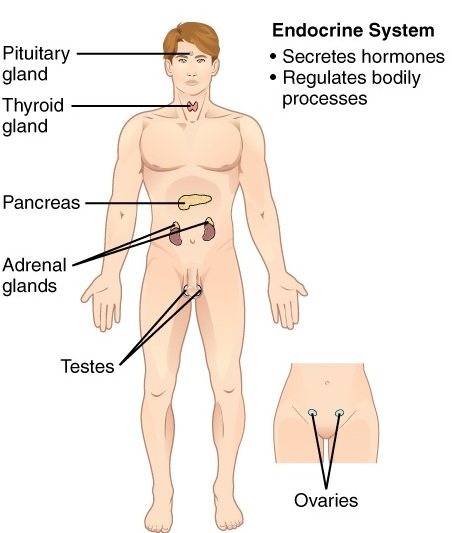
- Endocrine glands like the pituitary, thyroid, parathyroid, pancreas, pineal, adrenal glands and testes and ovaries are present in this system.
- The glands secrete their specific hormones, which human activity on different systems of the body and induce changes. These hormones are chemical messengers.
- For example, the melatonin, a pineal gland hormones, induce slumber at night.
- There are dissimilar hormones decision-making specific physiological processes.
eight. Reproductive organization
- This is the organ system that is responsible for the continuation of species.
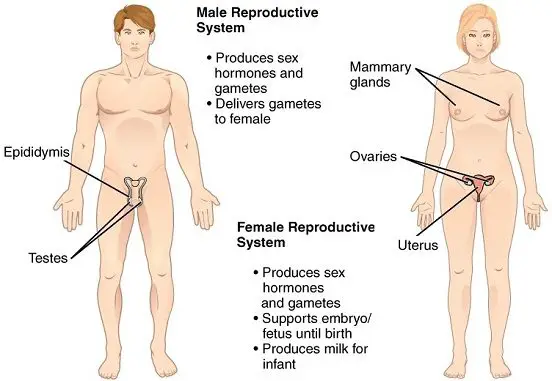
- It helps in the formation of offspring to keep up further life.
- In males, it comprises organs like the testis, penis, prostate glands.
- In females, information technology consists of the vagina, uterus, uterine tubes, ovaries, and likewise mammary glands (breast).
- This organisation is quite interesting in that it is just i set and depends on the opposite sex for its of import physiological process.
nine. Lymphatic arrangement
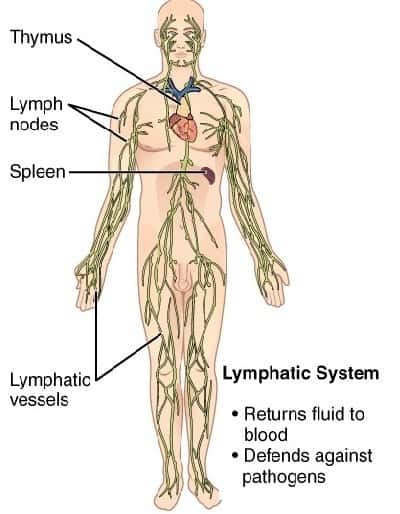
- This system provides a natural defense in the body. It kills bacteria, viruses, and other parasites residing in the body.
- It comprises of fluid lymph, lymph nodes, lymph organs (similar the spleen, tonsils, thymus), white claret cells, and antibodies (humeral substances).
- The lymphatic system is arranged parallel to the blood circulation and widely distributed in important points of the body.
- You can find it in the intestine, kidney, liver, encephalon, etc. where information technology traps the pathogens and prevents their further spread by destroying them.
10. Urinary system
- This system, as the proper name indicates, forms the urine as its end product.
- It is meant to remove the wastes and other toxins from the body.
- This organization has a pair of kidneys, a pair of ureters, one urinary bladder and a urethra.
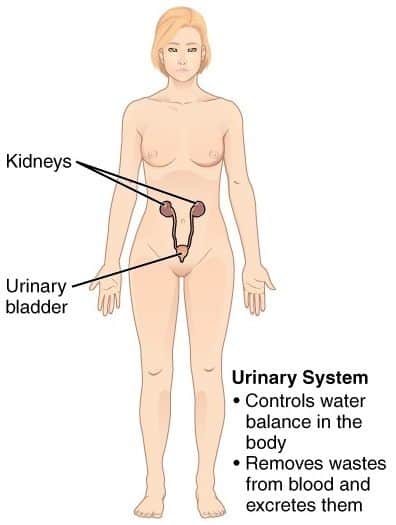
- Whatever substance in the trunk is converted to a water-soluble course by metabolism.
- This is transported past the blood to the kidneys.
- When the blood flows through the nephron in the kidney's, it gets filtered to releasing those wastes.
- This waste with water is called urine and is expelled out of the body by urination.
- The load on the kidney is reduced as other organs like the pare, lungs, and saliva as well participate in the excretion of waste from the body.
11. Integumentary system
- This is a covering system that covers the whole trunk surface.
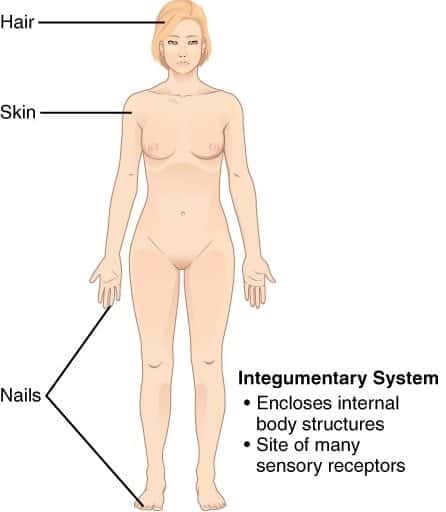
- The organs under this system are skin, pilus, nails, etc.
- Information technology prevents dehydration and estrus loss.
- It also keeps the body safety from damage, habiliment, and also infections.
Though the body has unlike organs and organ systems still, if one system is affected, other systems also refuse and cease to role.
So they are all interconnected and collaborate in functions.
Frequently asked question and answers.
-
What organ systems piece of work together?
Organ systems like the nervous arrangement and endocrine system, circulatory and urinary system, skeletal and muscular organisation work together.
-
Which organ systems incorporate the eye?
The eye can be placed in the nervous system as it is located in the encephalon compartment and is also mainly made of fretfulness.
-
What body systems piece of work together to maintain claret pressure level?
Blood pressure level is maintained by the nervous organization, circulatory systems, and urinary organization.
-
What organ systems piece of work together to maintain homeostasis?
The nervous organization and endocrine systems maintain homeostasis. The nervous system detects changes and gives out impulses by regulating hormones release.
-
Which organ systems work together to release energy from food
The systems involved in the release of energy from food include the digestive system which breaks down the food, the respiratory system which supplies oxygen for oxidative phosphorylation, and the circulatory system which carries the digested food and oxygen to the cells and tissues where energy is released.
-
Which ii organ systems work together to inhale oxygen
Mainly the nervous arrangement and respiratory system are involved. The respiratory middle in the brain triggers inhalation by the lungs. While lungs inspire to take in air.
-
What ii body systems work together to assist yous move
This would be the skeletal organization and muscular system.
Source: https://www.studyread.com/organ-systems-and-their-functions/
0 Response to "what organ system does the hypodermis belong to?"
Post a Comment